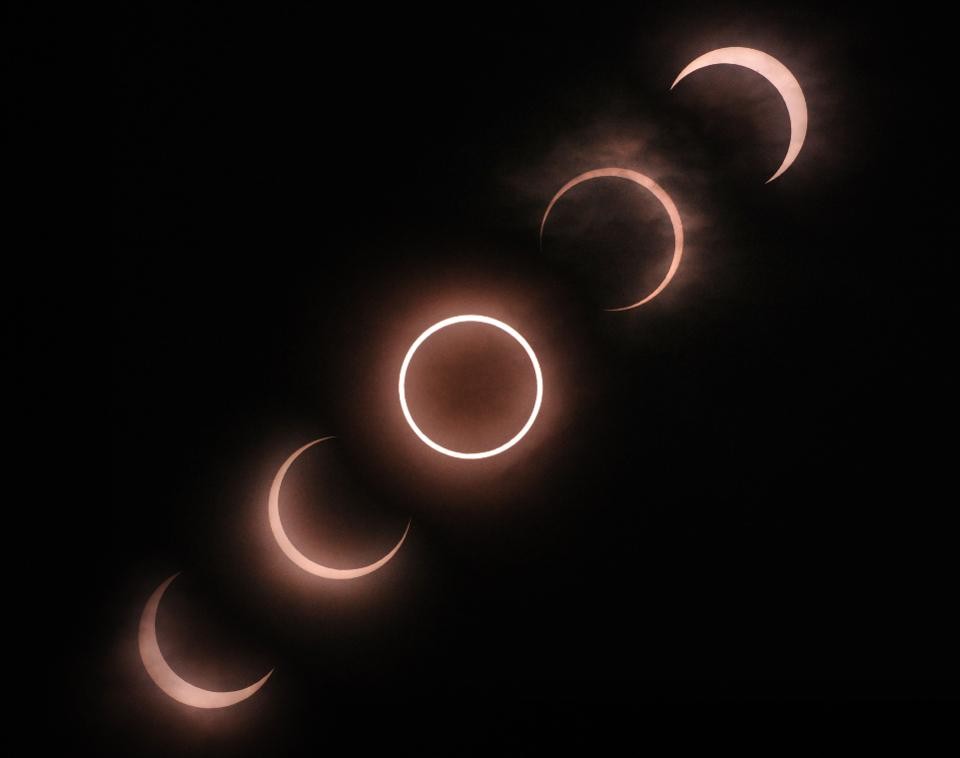In 2019, Christmas comes a little late in the day for nature lovers, sky-watchers and astronomers as the decade’s final solar eclipse rips across the globe.
Unlike the events of August 21, 2017’s “Great American Eclipse,” this one won’t be visible from North America, and nor will it be as impressive as that day’s total solar eclipse.
What begins at 03:43 a.m. Universal Time on December 26—that’s 10:43 p.m. EST and 7:43 p.m. PST on Christmas Day—is an annular solar eclipse. Since a New Moon is slightly further away than usual, it will appear smaller in the sky so will only block the center of the Sun’s disk. Observers will therefore see a ring around the Sun, and for a maximum of 3 minutes and 40 seconds.
However, it will be dangerous. In essence a partial solar eclipse, solar eclipse glasses must be worn at all times to avoid the threat of blindness. That makes it the most dangerous solar eclipse of 2019, since the peak of July’s total solar eclipse could be viewed with the naked eye.
It’s the third solar eclipse of 2019 after January 6, 2019’s partial solar eclipse in Russia and northeast Asia, and a total solar eclipse in South America on July 2, 2019.
Where is the annular solar eclipse happening?
The phenomenon—often referred to as a “ring of fire” or “ring of light”—will be visible at sunrise in Saudi Arabia, and then slightly higher in the sky from a narrow path through Qatar, the United Arab Emirates (UAE), Oman, southern India, Sri Lanka, Indonesia, Singapore and Malaysia. The Sun will then set as a “ring” east of Guam in the Pacific Ocean.
Is it safe to look at?
No. At least, not with the naked eye. An annular solar eclipse is effectively a particularly beautiful partial solar eclipse.
At its maximum, the Moon will block 97% of the Sun. That might sound like a lot, but in practice it’s not nearly enough to block the Sun’s light enough to look at the spectacle. So at all times eclipse glasses will be needed, as will solar filters on the front of telescopes or binoculars. That makes it easily the most dangerous solar eclipse of 2019.
However, observers may notice the light levels dim around them in the few minutes either side of “annularity.”
Where’s the best place to watch it?
As with all astronomical phenomenon, it’s advisable to go to where the spectacle will look its most dramatic, and where there’s the biggest chance of clear skies. Saudi Arabia fulfils both of those needs, and some eclipse-chasers will make their way to near Al-Hufuf around two hours northeast of Riyadh where it may be possible to see a “ring of fire” distorted as a bizarre sideways “D” shape right on the eastern horizon. That was last possible in May 2013 in Western Australia. If you’re planning such a trip, there’s some great advice here.
When is the next annular solar eclipse?
On June 21, 2020 there will be a rarer and far deeper kind of annular solar eclipse when the Moon very briefly blocks 99% of the Sun as seen from the Congo, Democratic Republic of Congo, South Sudan, Ethiopia, Eritrea, Yemen, Oman, Pakistan, India, Tibet, China, Taiwan and Guam. Seeing a sunrise “ring of fire” will be tricky, and Ethiopia (61 seconds), Oman (37 seconds) or Tibet (23 seconds) is where clear skies are predicted. Those watching from the edge of the path may just glimpse the Sun’s white-hot crown—its corona—which is normally visible as a halo only during totality at a total solar eclipse. Ditto Baily’s beads and even rare shadow bands.
When is the next annular solar eclipse in North America?
After a very long drought, North America is currently experiencing something of a boom in solar eclipses. In fact, the great American eclipse of 2017, although a major event at the time, will probably be remembered for being merely a precursor to a golden age of eclipses. Perhaps the biggest and most important so that the clips of most North American’s lifetime will be on April 8, 2024, when a total solar eclipse will be observable from 12 states across the U.S. The Great North American Eclipse?




